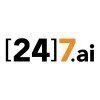
i
Amdocs
Filter interviews by
Amdocs Interview Questions, Process, and Tips
Amdocs Interview Experiences
516 interviews found
I applied via LinkedIn and was interviewed in Jan 2024. There were 2 interview rounds.
Aptitude test which consist of logical reasoning questions along with Quants and few questions related with domain. (Fiber counts, Fiber network diagrams).
(10 Questions)
- Q1. Introduce yourself
- Q2. What are your strenghts ?
- Ans.
My strengths include strong analytical skills, attention to detail, and excellent problem-solving abilities.
Strong analytical skills - able to analyze complex data and identify patterns
Attention to detail - meticulous in planning and executing fiber network designs
Excellent problem-solving abilities - adept at finding creative solutions to challenges
- Q3. In which departments you worked in your previous organization ?
- Q4. What is the difference between Boring and Trenching ?
- Ans.
Boring involves drilling a hole underground for installation, while trenching involves digging a trench for laying cables or pipes.
Boring involves drilling a hole underground using specialized equipment, while trenching involves digging a trench using machinery like excavators.
Boring is typically used when minimal disruption to the surface is desired, while trenching is used when a larger area needs to be excavated.
Bor...
- Q5. Why There is a standard of giving clearances from utilities while designing Optical fiber path ?
- Ans.
Clearances from utilities are necessary to avoid interference and damage to the optical fiber path.
To prevent accidental damage to the fiber optic cables during maintenance or construction work by utility companies.
To ensure that there is no interference from existing utility lines that could affect the performance of the optical fiber network.
To comply with safety regulations and standards to prevent accidents and ens...
- Q6. Which is cost effective method boring or trenching ?
- Ans.
Trenching is generally more cost effective than boring for fiber planning.
Trenching is typically cheaper upfront as it requires less specialized equipment and labor compared to boring.
Boring may be more expensive initially due to the need for specialized machinery and skilled operators.
However, in certain situations where trenching is not feasible or cost-effective, boring may be the preferred method.
Factors such as so...
- Q7. What is the minimum and maximum depth of bore and trench ?
- Ans.
The minimum and maximum depth of bore and trench varies depending on the specific project requirements and local regulations.
Minimum depth of bore and trench is typically around 24 inches to ensure proper protection and support for the fiber optic cables.
Maximum depth of bore and trench can range from 36 inches to 60 inches, depending on factors such as soil conditions, road crossings, and utility clearances.
Local regu...
- Q8. What is the width of conduit that we used to place ?
- Ans.
The width of conduit used for fiber placement varies depending on the number of fibers being installed.
Conduit width typically ranges from 1 inch to 4 inches for fiber placement.
The width is determined based on the number of fibers being installed and the type of fiber optic cables used.
For example, a conduit width of 1 inch may be sufficient for a small number of fibers, while a width of 4 inches may be needed for a l
- Q9. Why you want to join Amdocs ?
- Q10. Any questions from your end ?
Interview Preparation Tips
- Fiber Engineering
- Construction Management
- Project Management
- Resume preperation
- Outside plant engineering
Top Amdocs Fiber Planning Engineer Interview Questions and Answers
Fiber Planning Engineer Interview Questions asked at other Companies
I applied via Company Website and was interviewed in Dec 2024. There were 3 interview rounds.
Basic self evaluation test.
(3 Questions)
- Q1. What project I have completed and follow-up questions on that?
- Q2. How to handle class imbalance.
- Ans.
Handling class imbalance involves techniques like resampling, using different algorithms, and adjusting class weights.
Use resampling techniques like oversampling or undersampling to balance the classes.
Utilize algorithms that are robust to class imbalance, such as Random Forest, XGBoost, or SVM.
Adjust class weights in the model to give more importance to minority class.
Use evaluation metrics like F1 score, precision, r...
- Q3. Basic Python coding questions.
(2 Questions)
- Q1. Data-related questions.
- Q2. ML Ops questions.
Interview Preparation Tips
- Python
- MLOPS
Data Scientist Interview Questions asked at other Companies
I appeared for an interview in Feb 2025.
(1 Question)
- Q1. What is the hierarchy in JIRA?
- Ans.
JIRA hierarchy includes Boards, Projects, Issues, Epics, Stories, and Sub-tasks.
Boards are used to visualize and manage work in progress.
Projects contain issues and can be broken down into Epics, Stories, and Sub-tasks.
Epics are large bodies of work that can be broken down into Stories.
Stories represent individual units of work that can be further broken down into Sub-tasks.
(1 Question)
- Q1. What is the concept of risk management?
- Ans.
Risk management is the process of identifying, assessing, and prioritizing risks followed by coordinated and economical application of resources to minimize, monitor, and control the probability and impact of unfortunate events.
Identifying potential risks that could impact the project or organization
Assessing the likelihood and impact of each risk
Prioritizing risks based on their potential impact
Developing strategies t...
PMO Lead Interview Questions asked at other Companies
What people are saying about Amdocs





I applied via Campus Placement
1 coding question and MCQ on CS fundamentals were asked.
(3 Questions)
- Q1. Questions were on my project. It was a full stack project on MERN. I was asked about non blocking IO, promises, alternatives to react.
- Q2. I was asked a DSA question to find the set of element that occurs twice in the array. I was expected to run the code.
- Q3. I was asked basics about cloud and if I have any related experience as the role would be devops.
(1 Question)
- Q1. I was asked basics questions about myself. It was a very short 15 minute interview.
Associate Software Developer Interview Questions asked at other Companies
Amdocs interview questions for popular designations
Data structure related question
(4 Questions)
- Q1. Quesitions related to data structure, cloud
- Q2. Find the second highest integer
- Ans.
To find the second highest integer in an array, sort the array in descending order and return the second element.
Sort the array in descending order
Return the second element in the sorted array
Handle edge cases like duplicates or small arrays
- Q3. Question related to two sum
- Q4. Some sliding window problems
(1 Question)
- Q1. General Behavioral Questions
Interview Preparation Tips
Skills evaluated in this interview
Top Amdocs Software Engineer Interview Questions and Answers
Software Engineer Interview Questions asked at other Companies
Get interview-ready with Top Amdocs Interview Questions
I applied via Naukri.com and was interviewed in Dec 2024. There were 3 interview rounds.
Agenda could be anything but prepration should be in essential pointers
(1 Question)
- Q1. Tricky related to the any technical skills set
(1 Question)
- Q1. What has been your duration of employment with the organization?
- Ans.
I have been employed with the organization for 5 years.
Employed for 5 years
Started in entry-level position and progressed to current role
Received promotions and increased responsibilities over time
Interview Preparation Tips
Jobs at Amdocs
I appeared for an interview in Aug 2024.
(5 Questions)
- Q1. Core Java (OOPS, basic core java question)
- Q2. Java8 feature questions
- Q3. Linux Command Questions
- Q4. Spring boot questions (annotations, bean scopes, DI)
- Q5. Write a Junit test case
- Ans.
Writing a Junit test case for a software engineer interview
Create a test class that extends TestCase or uses the @Test annotation
Write test methods that test specific functionality of the code
Use assertions to verify expected outcomes
Set up any necessary test data or mocks before running the test
Use annotations like @Before and @After for setup and teardown tasks
(3 Questions)
- Q1. It was technical plus managerial round
- Q2. Mostly question is asked on resume, so please be mindful while putting anything on resume as you need to justify each thing
- Q3. Why you want to join amdocs?
- Ans.
I want to join Amdocs because of their reputation for innovation and their commitment to employee growth.
Amdocs is known for its cutting-edge technology solutions in the telecommunications industry
I am impressed by Amdocs' focus on continuous learning and development for its employees
I believe that Amdocs offers a dynamic and challenging work environment that will help me grow as a software engineer
Top Amdocs Software Engineer Interview Questions and Answers
Software Engineer Interview Questions asked at other Companies
I applied via Campus Placement
(2 Questions)
- Q1. Programming MCQ's
- Q2. Coding and SQL Questions
(2 Questions)
- Q1. Coding Question
- Q2. Questions based on projects done in college
(2 Questions)
- Q1. Basic Introduction
- Q2. Family Background
Interview Preparation Tips
Top Amdocs Associate Software Engineer Interview Questions and Answers
Associate Software Engineer Interview Questions asked at other Companies
(3 Questions)
- Q1. What is bigadata
- Ans.
Big data refers to large and complex data sets that are difficult to process using traditional data processing applications.
Big data involves large volumes of data
It includes data from various sources such as social media, sensors, and business transactions
Big data requires specialized tools and technologies for processing and analysis
- Q2. How spark works
- Ans.
Spark is a distributed computing framework that processes big data in memory and is known for its speed and ease of use.
Spark is a distributed computing framework that can process data in memory for faster processing.
It uses Resilient Distributed Datasets (RDDs) for fault-tolerant distributed data processing.
Spark provides high-level APIs in Java, Scala, Python, and R for ease of use.
It supports various data sources li...
- Q3. Explain your application
- Ans.
Our application is a data engineering platform that processes and analyzes large volumes of data to provide valuable insights.
Our application uses various data processing techniques such as ETL (Extract, Transform, Load) to clean and transform raw data into usable formats.
We utilize big data technologies like Hadoop, Spark, and Kafka to handle large datasets efficiently.
The application also includes machine learning al...
Interview Preparation Tips
Data Engineer Interview Questions asked at other Companies
(2 Questions)
- Q1. What are the key concepts of Object-Oriented Programming (OOP)?
- Ans.
Key concepts of OOP include encapsulation, inheritance, polymorphism, and abstraction.
Encapsulation: Bundling data and methods that operate on the data into a single unit (object).
Inheritance: Allowing a class to inherit properties and behavior from another class.
Polymorphism: Objects of different classes can be treated as objects of a common superclass.
Abstraction: Hiding complex implementation details and showing onl
- Q2. What is the internal working mechanism of a HashMap?
- Ans.
HashMap is a data structure that stores key-value pairs and uses hashing to quickly retrieve values based on keys.
HashMap internally uses an array of linked lists to store key-value pairs.
When a key-value pair is added, the key is hashed to determine the index in the array where the pair will be stored.
If multiple keys hash to the same index (collision), a linked list is used to store these pairs.
To retrieve a value, t...
Top Amdocs Software Developer Interview Questions and Answers
Software Developer Interview Questions asked at other Companies
Easy to medium questions
(2 Questions)
- Q1. Linked list insertion deletion
- Q2. Reversal of nodes in linked list
- Ans.
Reversing the nodes in a linked list involves changing the direction of pointers to go from the end to the beginning.
Iterate through the linked list and reverse the pointers to point to the previous node instead of the next node.
Use three pointers - prev, current, and next - to keep track of the nodes while reversing the list.
Update the head of the linked list to point to the last node after reversing.
Skills evaluated in this interview
Top Amdocs Software Developer Interview Questions and Answers
Software Developer Interview Questions asked at other Companies
Amdocs Interview FAQs
Some of the top questions asked at the Amdocs interview -
The duration of Amdocs interview process can vary, but typically it takes about less than 2 weeks to complete.
Tell us how to improve this page.
Amdocs Interviews By Designations
- Amdocs Software Developer Interview Questions
- Amdocs Associate Software Engineer Interview Questions
- Amdocs Software Engineer Interview Questions
- Amdocs Functional Test Engineer Interview Questions
- Amdocs RF Engineer Interview Questions
- Amdocs Softwaretest Engineer Interview Questions
- Amdocs Senior Software Engineer Interview Questions
- Amdocs Devops Engineer Interview Questions
- Show more
Interview Questions for Popular Designations
- Software Developer Interview Questions
- Associate Software Engineer Interview Questions
- Software Engineer Interview Questions
- Functional Test Engineer Interview Questions
- RF Engineer Interview Questions
- Softwaretest Engineer Interview Questions
- Senior Software Engineer Interview Questions
- Devops Engineer Interview Questions
- Show more
Amdocs Interview Process
based on 358 interviews
Interview experience
Explore Interview Questions and Answers for Top Skills at Amdocs






Interview Questions from Similar Companies
Fast track your campus placements
Amdocs Reviews and Ratings
based on 4.1k reviews
Rating in categories
|
Software Developer
8.2k
salaries
| ₹5 L/yr - ₹17 L/yr |
|
Software Engineer
1.9k
salaries
| ₹4 L/yr - ₹16 L/yr |
|
Softwaretest Engineer
1.7k
salaries
| ₹2.9 L/yr - ₹14 L/yr |
|
Functional Test Engineer
1.2k
salaries
| ₹4 L/yr - ₹12.1 L/yr |
|
Associate Software Engineer
1k
salaries
| ₹3.5 L/yr - ₹12 L/yr |

TCS

IBM

Oracle

Carelon Global Solutions
- Home >
- Interviews >
- Amdocs Interview Questions



















